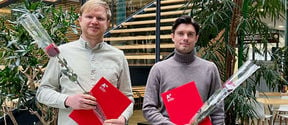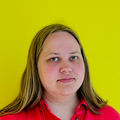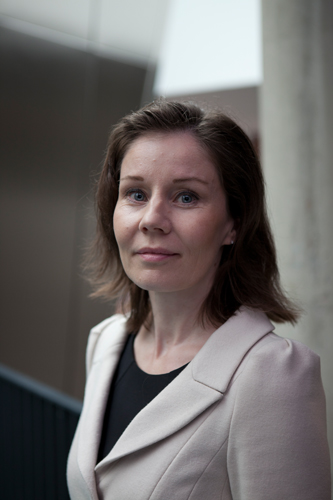Best doctoral theses and master's theses 2023 in the School of Science awarded
SCI granted awards to seven doctoral theses and five master's theses

Kukka-Emilia Huhtinen started as a student in the Quantum Dynamics group led by Prof. Päivi Törmä already in 2016. She graduated in June 2023 with a doctoral degree for her thesis entitled “Superconductivity and normal state properties in flat bands”. This year in March, Huhtinen won an Aalto thesis award for her outstanding doctoral thesis work which also includes four original, highly-acclaimed journal articles. In addition to the Aalto award, Huhtinen was also very recently awarded the highly prestigiousMikael Björnberg’s Memorial Fund Prize by the Finnish Society for Science and Letters.
In this online article, Huhtinen reflects on her experience as a doctoral student and shares valuable insight about her studies.
Broadly speaking, Huhtinen examined in her thesis the properties of so-called flat (energy) bands in materials that could potentially find use as high temperature superconductors. Superconductivity itself is achieved when electrons flow within a material without encountering any resistance, meaning energy lost as heat, for instance. As such, identifying superconductors operating at room temperature is one of the grand challenges in condensed matter physics and the topic is currently of high international interest. Applications for high temperature superconductivity range from energy-efficient IT devices, communications, transportation to medicine and beyond. Prof. Törmä herself has launched in 2022 an international consortium called SuperC where top scientists work together with the mission to identify a solution to this long-standing issue.
Flat (=dispersionless) energy bands offer the potential of reaching very high critical temperatures of superconductivity. It has already been predicted by Törmä’s group earlier that superconductivity in these flat bands is possible due to suitable quantum geometry which was a novel concept at the time. In particular, previous work by the QD group predicted that a key quantity of superconductivity, the superfluid weight, is proportional to a quantum geometric quantity called quantum metric. This result was widely utilized in the community (the original published work has over 400 citations), until Huhtinen in her PhD research stumbled on a fundamental flaw in this relation: the quantum metric depends on the choice of basis, while the superfluid weight does not. Not only did Huhtinen realize this but, even more importantly, she invented herself a new concept, the minimal quantum metric, which now provides the correct and rigorous basis for the connection between superconductivity and quantum geometry. This was work carried out by Huhtinen extremely independently according to her supervisor. Huhtinen herself mentions that her discovery came about after a lot of discussions with members of the Quantum Dynamics group and also digging into the supplementary material of publications.
Huhtinen’s thesis contains thus a major conceptual breakthrough, namely new understanding on the quantum geometric contribution to superconductivity. The publication where this is presented, first-authored by Huhtinen, has already received over 60 citations in Google Scholar since its publication in 2022. This is an exceptional achievement for an article in theoretical physics, Törmä points out.
The long-term significance of Huhtinen’s PhD is expected to be high. “Her work lays the foundation to correct understanding of how flat band superconductivity is influenced by quantum geometry. This gives the guideline for the search of superconductors that work at much higher temperatures than present day ones that require cryogenic cooling”, explains Törmä.
Kukka-Emilia HuhtinenSimply having to organize one's thoughts to explain them to someone can already lead to big steps forward, and others' perspective can help understand things in a completely new way
During her thesis work, Huhtinen came to understand and appreciate the importance of discussions with other researchers. “Even though I got to do a lot of my research very independently, regular group meetings and discussions outside of them played a big role in getting me unstuck at several points. Simply having to organize one's thoughts to explain them to someone can already lead to big steps forward, and others' perspective can help understand things in a completely new way”, Huhtinen comments. This was of course more of a challenge during the pandemic years, which weighed on Huhtinen despite the fact that she also likes some level of isolation. “But even I was very happy to return to the office in the end”, she adds.
“I think one of the most important decisions of a PhD student occurs at the point of choosing a supervisor. I was lucky to have worked in Törmä’s group before on special assignments and a master's thesis and knew that she was the right supervisor for me”, Huhtinen explains. She reckons that both allowing the student to gain independence, while also maintaining structure and support as well as expecting high quality work that occasionally even forced her out of her comfort zone were all extremely useful attributes. Then there is trust- Huhtinen says she was always sure her supervisor had her best in mind. “Päivi Törmä made me undoubtedly a better scientist with her supervision”, Huhtinen states openly.
Vice versa, Törmä has several comments about Huhtinen’s ability as her student. Firstly, she remarks that the numerical implementation of some of Huhtinen’s calculations was a formidable challenge. “I would usually consider such a problem impossible for a PhD student to solve alone without a supporting postdoc or more senior student”, Törmä explains. “Huhtinen’s results are based on extremely thorough, critical, creative and technically demanding theoretical work. To be able to make a clear breakthrough on a demanding, deep theory problem is a remarkable achievement for a PhD student”, Törmä elaborates further. In her time as a doctoral student, Huhtinen also supervised several younger students next to her own work.
Kukka-Emilia HuhtinenDuring my PhD studies, I learned a lot about how I like to do things, and that would have been almost impossible had I been unwilling to get out of my comfort zone
“I would recommend any new PhD students to keep an open mind even when faced with ideas or methods they find unintuitive or even tedious at first. During my PhD studies, I learned a lot about how I like to do things, and that would have been almost impossible had I been unwilling to get out of my comfort zone”, Huhtinen adds. “Critical thinking is also crucial, and it should be applied equally to what you and others have done. Sometimes things do not make sense because you personally do not understand them, and other times it turns out no-one actually fully does. The latter scenario is where really interesting things can happen, but either way, you are learning” is what Huhtinen concludes.
Kukka-Emilia Huhtinen is currently conducting postdoctoral work at ETH Zürich under the supervision of Prof. Sebastian Huber.
Link to Kukka-Emilia Huhtinen's doctoral thesis
Superconductivity and normal state properties in flat bands (aalto.fi)

SCI granted awards to seven doctoral theses and five master's theses




